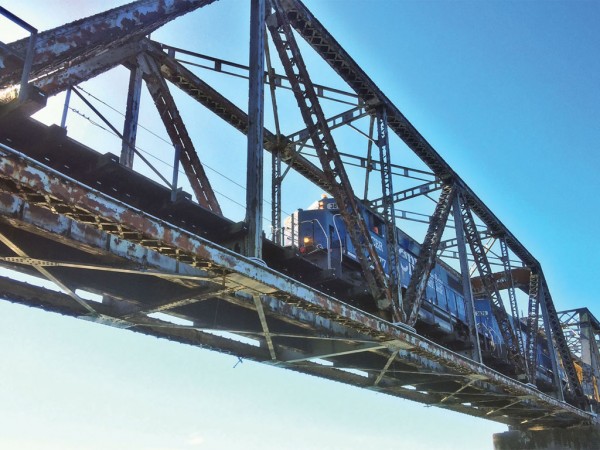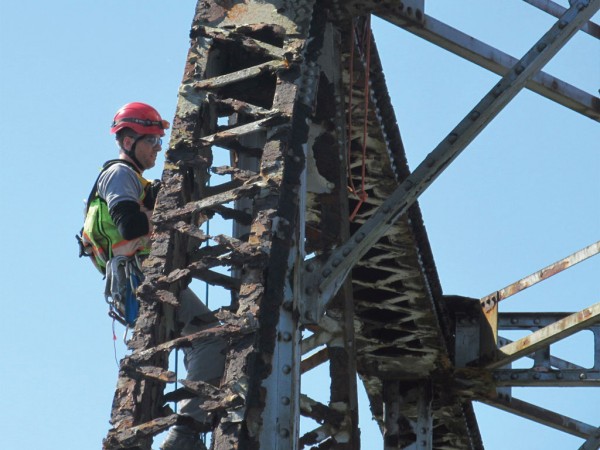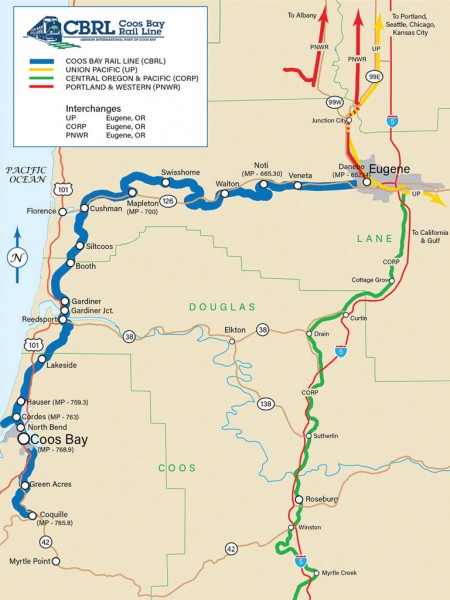By Gene Davis, Senior Railway Engineer, Stantec
For over 100 years, the Port of Coos Bay has been a key player in the economic growth and development of Southwestern Oregon, and of the entire state. The 134-mile regional rail spans from Coquille, Oregon, connecting with the National Railway Network at the Union Pacific Yard in Eugene. The line includes 121 bridges, and has supported the region’s economic vitality, providing direct, efficient and cost-effective access to regional, national and global markets for generations.
After exhaustive efforts to purchase and rescue the rail line, the Oregon International Port of Coos Bay acquired the Coos Bay Rail Line (CBRL) in 2011, and freight rail service was re-established.
The Port’s mission to promote sustainable development that enhances the economy of southwest Oregon and the State was underway, but the multi-year process of getting the rail line up to full service was just about to begin.

Inspection by Land, Sea and Air
The Port of Coos Bay brought Stantec on board in 2012 to inspect and load rate all 121 bridges, review and perform field verification of existing inspection and load rating reports and prepare a scope of work and bid documents for the proposed bridge repairs to move towards full active service. Three bridges are swing-span movable bridges, one of which is the longest in North America. Bridge structures are varied, and include steel truss, through plate girder, and deck plate girders spans, concrete box spans, and a multitude of timber trestles. Many structures were first built between 1914 and 1916, when the line first opened, and are now over 100 years old.
In order to meet projected timelines and the needs of the Port, Stantec brought in bridge inspectors from as far away as Denver (CO), Duluth (GA), Fairmont (WV), Lexington (KY), Manitoba (CA), and Raleigh (NC). Teams rotated in and out, working daily ten-hour shifts for two weeks at a time. Specialized rope access inspection engineers sped up the process considerably, as did water-based inspections from the undersides of bridges.

Further to the inspection program, Stantec assisted the Port of Coos Bay to develop a Bridge Management Program, complying with the Federal Railroad Administration’s (FRA) standards to ensure the structural integrity of bridges, culverts and tunnels that support or contain railroad tracks. The FRA established its standard guidelines in 2012, which fully took effect on September 13, 2017, to ensure that bridge owners had in place sufficient bridge inspection, repair and/or replacement procedures to prevent bridge failures across the United States. For the Port, this was an opportunity to follow federal guidelines while launching their plan to deliver safe, reliable freight rail.
Rehabilitation and Reconstruction
The next leg of project support includes construction management services as repairs are put into action. Improvements and replacements for selected key bridge structures will upgrade capacity, increase safety and reliability on the line, and extend the life of the selected structures, building on repairs made in 2010 to return the line to service.
The planned work includes rehabilitating all three of the Swing Span bridges, replacing the Vaughn Viaduct Bridge near Eugene, replacing the Coal Bank Slough bridge in Coos Bay, and upgrades to timber, concrete and steel structures to meet planned train load capacities and speed targets necessary to maintain continued traffic growth on the line.
Stantec provided the cost-benefit for a successful BUILD Grant application to the U.S. Department of Transportation, awarded in late 2018. The grant will dedicate $20 million to next phases of the project, matched by $5 million from the Port of Coos Bay.
Phase 1, which is slated to commence in 2019, will see the Vaughn Viaduct Bridge replaced. Already designed as a 5-span precast concrete girder structure, the new bridge has a planned offset alignment to allow for continued freight operations during construction. As construction reaches completion, the rail line will be connected to the new bridge over a weekend as the old bridge is disassembled. This construction strategy will minimize disruptions to rail service.
Phase 2 will include steel repairs and bridge strengthening in order to increase speed through the network. Phase 3 will replace the Coolbank Slough Bridge, which had its swing mechanism fail in 1986 and has been operating as a fixed bridge ever since.
Once the important work on this stage of the project is completed, the rail line will be restored to a mix of Track Classification 2 with an allowable speed of 25 mph, and a Track Classification 3, with a maximum speed of 40 mph.
Future Freight in Southwestern Oregon
The significant rail infrastructure investments the Port of Coos Bay has implemented utilizing state and federal grants – approximately $90 million plus $20 million from the BUILD award – have produced ongoing economic vitality for the region.
The Coos Bay line currently transports $220 million worth of freight every year, serving 9 shippers across Lane, Douglas, and Coos counties, some with multiple locations. These local firms employ approximately 1,000 workers.
The Port has a strong interest in attracting significant investment to the region and expanding operations. Direct benefits of expanded investment will equal hundreds of direct and indirect jobs, as well as increased tax revenue for state and local governments through additional business activity.

As the Port of Coos Bay continues its investment in improved freight rail operations, Southwestern Oregon businesses will continue to get their products to distant markets, and the local communities will continue to feel the economic benefits that come from freight rail service.
Editor’s Note: As a civil engineer and freight rail lead for Stantec, Gene Davis goes wherever the rails take him. And they’ve taken him all over North America, from the East Coast where he has worked on track, structure, and construction projects as part of the Norfolk Southern Engineering Department, to the West Coast where he is currently leading bridge engineering (including specialized inspection) services for the Oregon International Port of Coos Bay.

